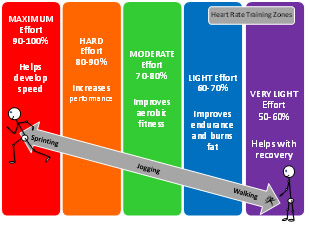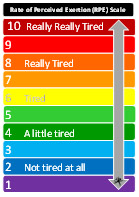Muscular Fitness
Quick LinksRoutines: Upper body Resistance bands routine Beginning Medicine ball routine Resources: Information Sheet (PDF) Rate of Perceived exertion scale |
Why engage in strength and endurance exercises?
Completing exercises that work on muscular strength and endurance have many benefits. These include making everyday activities easier, reducing soreness that can come from participating in everyday activities, increasing your metabolism, reducing the chance of becoming injured, building stronger bones, relieving stress, reducing blood pressure, and reducing body fat (Physical Best, p.52).
Definitions
- Muscular Endurance: To exert a submaximal force against resistance repeatedly through the full range of motion (Physical Best definition).
- Muscular Strength: To exert a maximal effort against resistance.
Safety
Proper technique is important when completing a muscular fitness routine. Below are several suggestions to help reduce injury and aid in your performance.
- Use little to no resistance when first completing an exercise.
- Complete exercises at a slow, controlled, and steady pace.
- Complete exercises in a non jerky action through a full range of motion.
- Do not hold your breath when completing the exercises. Breathe in through your nose and out through your mouth when exercising.
- Rest after each set (30-90 secs.)
Heart Rate (HR)
 Heart rate is measured by beats per minute and can be taken at the neck (carotid artery) or the wrist (radial artery). The Heart Rate Training Zone chart presents five heart rate training zones. To use this chart, first calculate your maximum heart rate. MHR = (220-age). Then you can multiple this number by 50%-60% to get your heart rate range for the very light effort zone. You can use this same procedure to calculate your heart rate range for the other zones. Below is an example of the heart rate range for a 12 year old.
Heart rate is measured by beats per minute and can be taken at the neck (carotid artery) or the wrist (radial artery). The Heart Rate Training Zone chart presents five heart rate training zones. To use this chart, first calculate your maximum heart rate. MHR = (220-age). Then you can multiple this number by 50%-60% to get your heart rate range for the very light effort zone. You can use this same procedure to calculate your heart rate range for the other zones. Below is an example of the heart rate range for a 12 year old.
MHR = (220 -12) = 208
208 x .5 = 104
208 x .6 = 125
Rate of Perceived Exertion (RPE)
 The rate of perceived exertion scale (RPE) is a way to measure your feeling of fatigue during exercise. It is a subjective measure of effort. These feelings come from physical sensations you experience when you exercise. These feelings can be measured through increased heart rate, breathing rate, sweating, and muscle fatigue. There is a correlation between the RPE scale and HR. The higher your heart rate the higher on the RPE scale you will be.
The rate of perceived exertion scale (RPE) is a way to measure your feeling of fatigue during exercise. It is a subjective measure of effort. These feelings come from physical sensations you experience when you exercise. These feelings can be measured through increased heart rate, breathing rate, sweating, and muscle fatigue. There is a correlation between the RPE scale and HR. The higher your heart rate the higher on the RPE scale you will be.
To use the RPE scale you want to combine all of your senses you feel during physical activity. For example, what is your heart rate, breathing rate, physical stress, perspiration, fatigue level, and effort. While you are exercising think of the above and provide a rating for the exercise. If you are walking slowly you might be at a 1-2, whereas if you are running a sprint you may be closer to a 9-10.
How long should you exercise?
When working on muscular fitness (endurance and strength), it is important to follow the FITT Principle Guidelines. The FITT principle is a set of rules to help you get the most out of your exercise sessions. The table below can guide you for different age groups.
|
9-11 years |
12-14 years |
15-16 years |
17+ years |
Frequency |
2 to 3 days per wk |
2 to 3 days per wk |
2 to 3 days per wk |
2 to 3 days per wk |
Intensity |
Strength 60-90% |
Strength 60-90% |
Strength 60-90% |
Strength 60-90% |
Time |
1 set |
1 set (can do 2-3 sets) |
1 set (can do 2-3 sets) |
2-3 sets |
Type |
Very light weight, Major muscle groups, 1 exercise/muscle group |
Light weight, Major muscle groups, 1 exercise/muscle group |
Moderate weight, Major muscle groups, 2 exercises/muscle group |
Moderate to heavy weight, Major muscle groups, 8-10 exercises |
Table modified from Physical Best Activity Guide: Middle and High School Levels. 2nd Edition. (2005) p. 53
How do I create a Muscular Fitness routine?
Make sure to familiarize yourself with the exercises you will be performing. Perform the exercises in isolation before combining them into a sequence. It is important to be able to perform the exercises correctly to reduce injury.
To begin, select four to six exercises. Arrange the exercises from 1 to 4 or 1 to 6. Start with the 1st exercise and go through to the 6th exercise. When your strength and endurance improves, increase your routines by increments of 5 seconds or 5 repetitions. For example: if you are completing a resistance band routine, begin with 5 bicep curls and as you gain endurance or strength increase to 10 or begin by completing the bicep curls for 5 seconds and increase to 10 seconds.
Here are four routines you can try: